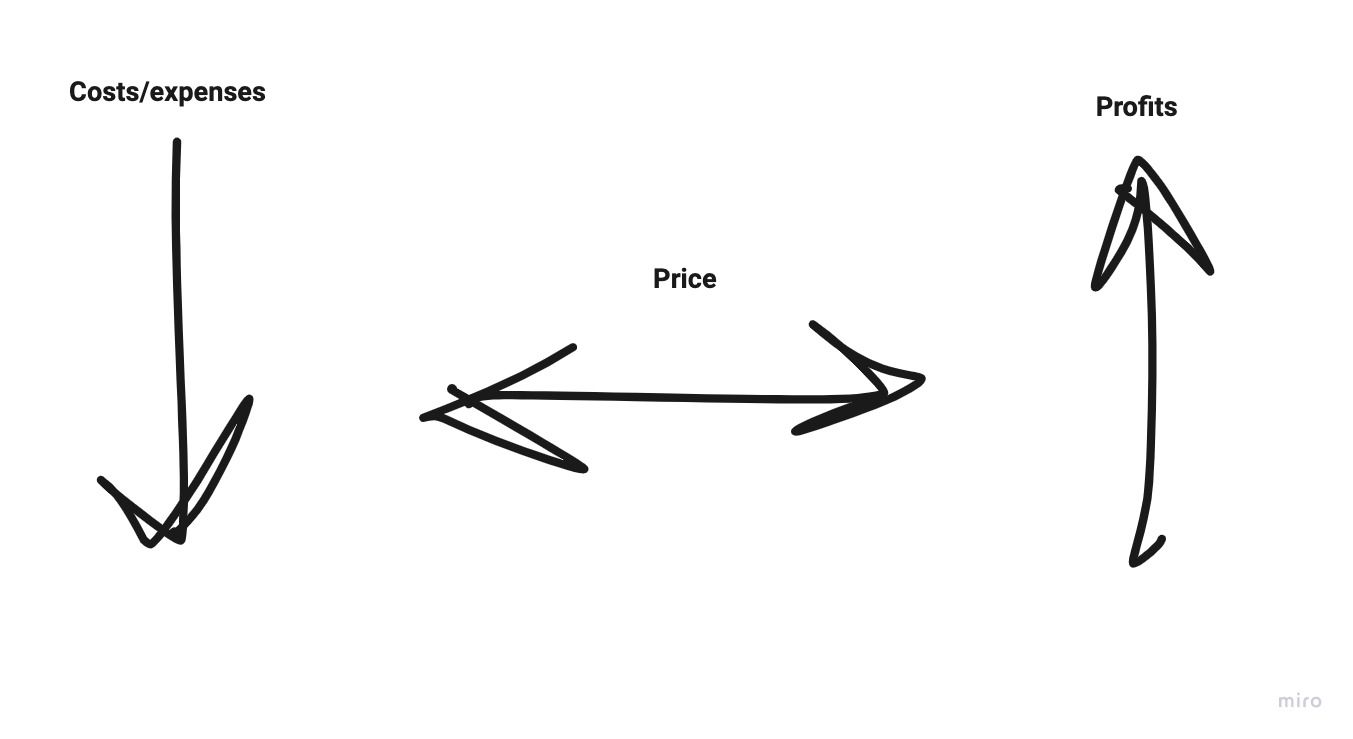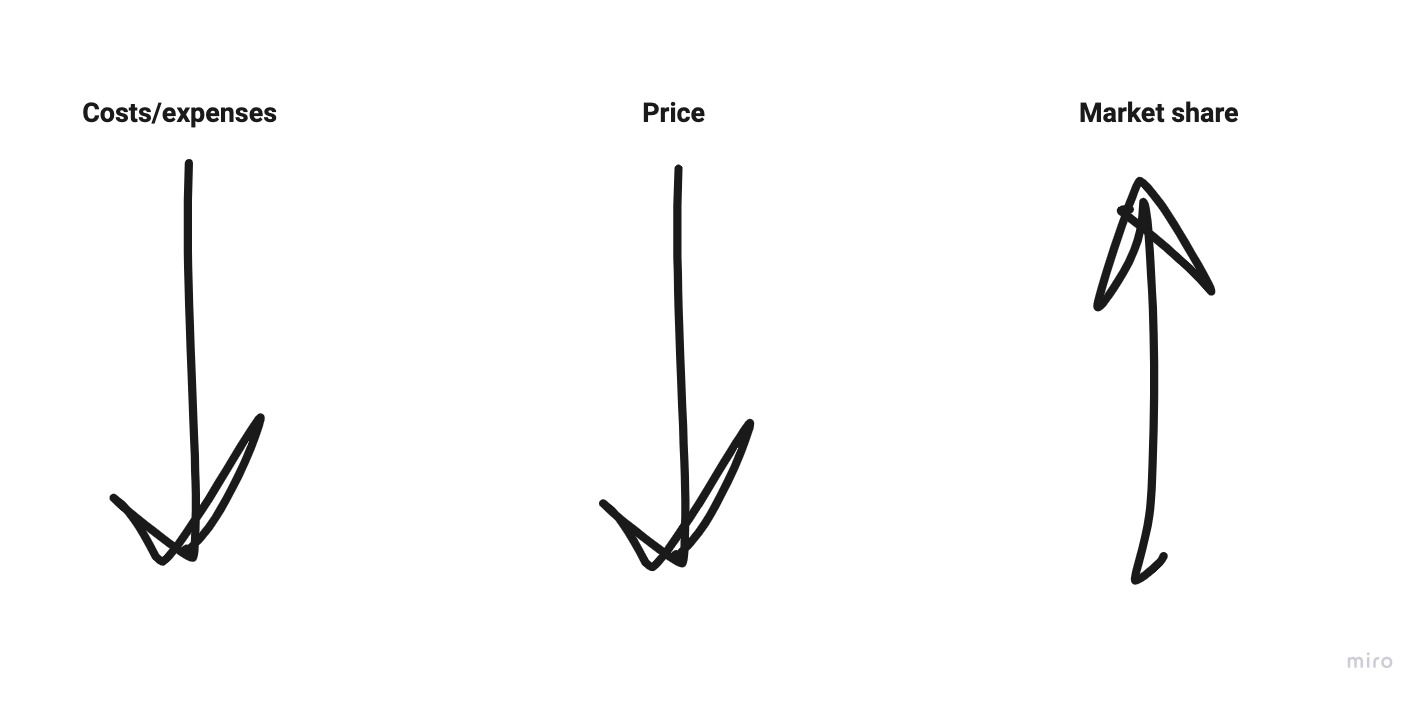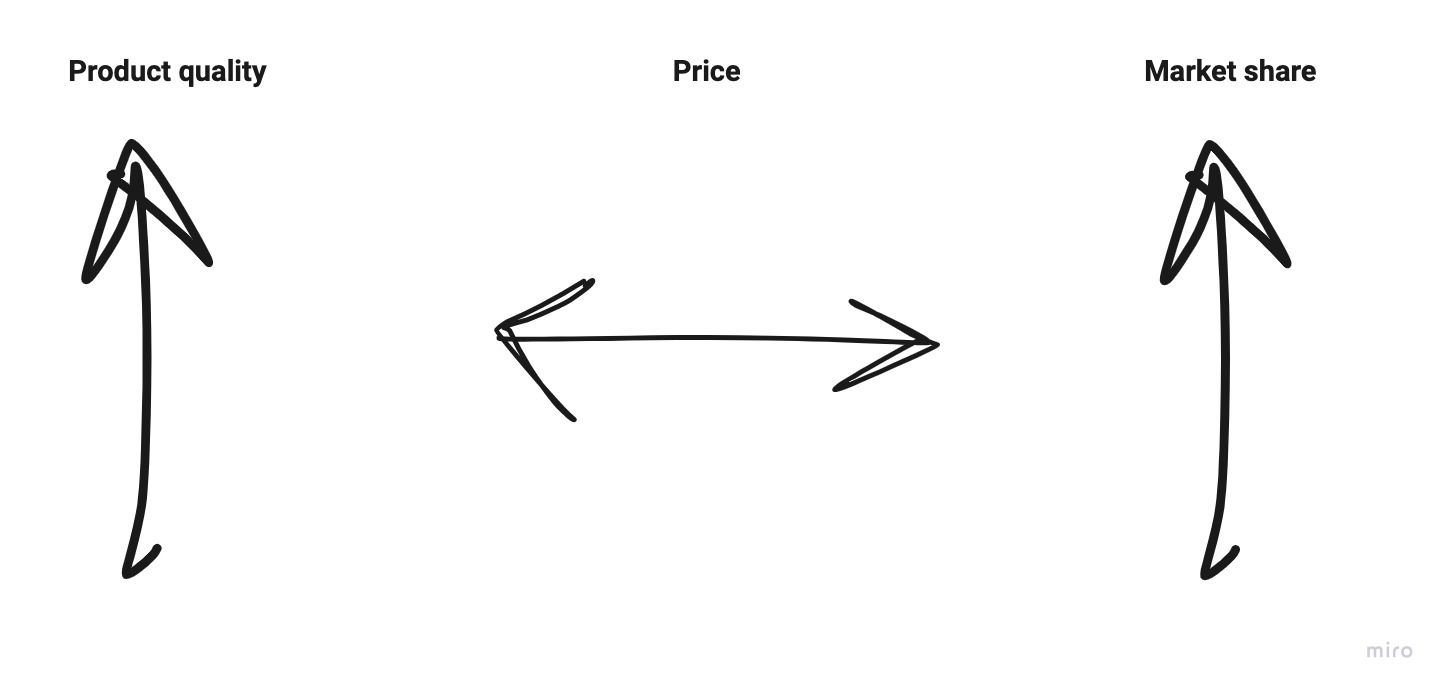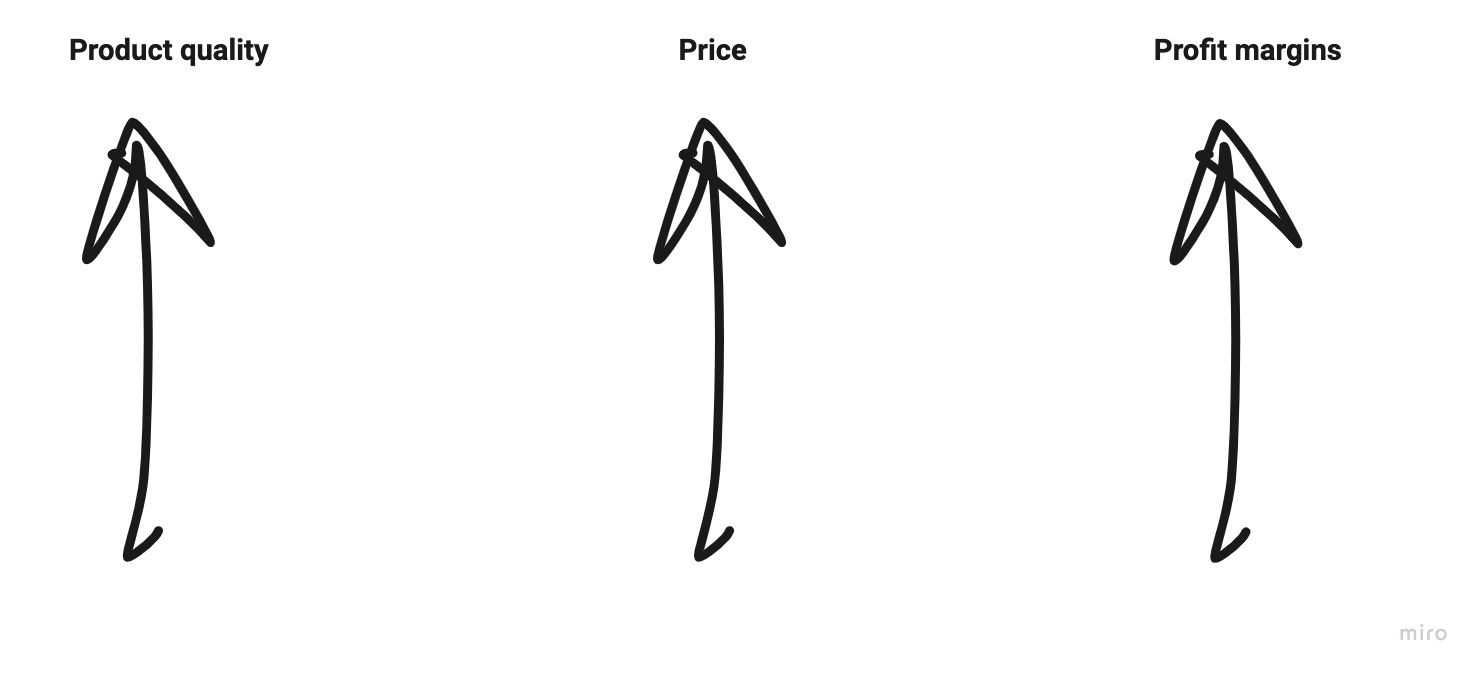What is the difference between low cost and differentiation strategies?
Low cost and differentiation are both competitive strategies for growth. They’re attempts at establishing competitive advantages.
A low cost provider strategy has you aim to beat the competition on costs (and often, but not necessarily, on price) by driving your own costs to manufacture down.
A differentiation strategy has you aim to boost profits by offering more value for the same price, and thus winning greater market share, or offering enough value to justify a higher price, meaning more profit per unit.
Let’s delve into those differences in a bit more detail.
Low cost provider strategy

Low cost providers look to cut the costs to themselves of producing and fulfilling a good or service.
Here’s an example.
If you supply IT services to businesses and include as part of your service the:
- Structured cabling,
- Remote server management,
- Security…
… and all the other IT service providers in your area offer the same, how do you beat them over time?
With a low cost strategy, you’d aim to reduce how much it costs you to do business.
That means:
- Negotiating deals with your cabling and hardware suppliers.
- Negotiating cheaper software deals, or using open source.
In doing so, you widen the gap between the price you charge for your service, and the cost to you of fulfilling it. In other words, you increase your profit margins.
Now, you’re able to reinvest this excess profit back into your service to further differentiate yourself. OR you can pass the savings onto your customers and offer a cheaper price.

Fast food vs fine dining


Another way to bring down costs is to reduce the number of products or services you offer, or to simplify the ones you do. When there’s less variation, you’re more efficient, making it cheaper to fulfill a smaller number of services.
Think of McDonald’s, with its highly standardized menu items. No matter where you go in the country, the experience is nearly identical. This helps them keep prices low.
Standardization brings down costs for the following reasons:
- It’s easier to train staff.
- You can use specialized equipment to automate parts of the process.
- It creates shorter feedback loops, so you can improve your products faster.
A business with a differentiation strategy, on the other hand, is more like a fine dining restaurant. They offer something unique. They elevate the experience with finer ingredients, or more powerful features. What they’re offering is, for its uniqueness and quality, worth a higher price.
The aims of a low cost provider
In summary, low cost providers aim to increase profit margins primarily by reducing their costs of doing business.
Many, as a result, look to position themselves as the cheapest competitor in the market by passing on their savings to customers. Let’s say you’ve done the market research to know that 40% of the market just wants the cheapest option possible. If you do the math to show you can produce a product, put it in front of that 40%, and sell it for the cheapest price and still turn a profit, then you have a profitable business model.
But this doesn’t have to be the case. Sometimes, they’ll use their larger profits to increase the value they offer with their product. You might be happy for one competitor to have you beat on price, but if your product is 25% more expensive, but demonstrably 100% higher quality, then your product is better value.
For example, if a bottle of your 500ml detergent costs $1.25 to your competitor’s $0.99, but yours lasts twice as long and cleans more effectively, then your product is better value.
A low-cost strategy can give you the excess profits needed to invest in the R&D necessary to discover how to make your product last twice as long as the competition’s.
Already, you’re beginning to differentiate yourself, which brings us to the next strategy.
Differentiation strategy
A differentiation strategy has you aim to beat your competitors by offering something they don’t.
This could be a unique feature, a better version of something everyone else offers, or something as simple as excellent customer service in an industry where service is typically poor.
Two ways of increasing profit with a differentiation strategy
When you offer a better product than the competition for a similar price, you win market share from them, driving a higher volume of sales, and thereby making a greater profit.

Alternatively, you can use your product’s better value to increase your prices without reducing your volume of sales. This increases your profit margins per sale.
With this second approach, though, there aren’t any savings to pass onto your customers. The increase in your profits comes from your ability to charge more, or have more people pay the same price. That said, you can still reinvest additional profits to find new ways of driving down costs, further increasing your profit margins.

A drawback of differentiation strategies
You have to invest more in product management and development, customer feedback, and multiple iterations of your product before you’ll have successfully developed something that persuades people it’s worth paying more for.
For that reason, you automatically preclude yourself from being the cheapest on the market. But you can still turn a profit by charging more for a more valuable customer experience.
Know what the market wants
If your differentiation strategy is to succeed, it’s very important you know what the market actually wants. If you offer a new feature nobody wants, you’ll have little chance of persuading people to pay higher prices for it.
In short, differentiation strategies have you strive to occupy a unique position in the market by having something that makes you different. Then you charge more for that uniqueness.
Broad and focused competitive strategies
There are two more subdivisions of low cost and differentiation strategies: broad and focused.
These are exactly what you’d think: broad strategies target a broad section of the market, while focused strategies (also known as niche market strategies) target a market niche.
A broad low cost strategy aims to appeal to a broad cross section of the market while lowering costs as much as possible.
A focused low cost strategy focuses on a niche market segment while, again, lowering costs as much as possible.
A broad differentiation strategy aims to appeal to a broad cross section of the market while charging higher prices, which the market accepts as a result of product differentiation.
A focused differentiation strategy targets a specific niche while charging higher prices which, again, the market accepts as a result of product differentiation.


When should you use a focused low cost strategy?
Low cost strategies make most sense for businesses that have them in mind from the start. That’s because they tend to rely on economies of scale to succeed, which require some careful planning to implement.
Economies of scale
Economies of scale drive down costs by virtue of the greater efficiency of batching tasks and purchases together.
When you go to the grocery store, you’ve no doubt noticed those huge bags of rice cost less per pound than the smaller bags. That’s an economy of scale. In a similar way, if a business knows it has to fulfill 100,000 orders instead of 10, it gets bulk discounts when it orders 100,000 parts for its products.
How this creates a competitive advantage
Add all these discounts together for all the parts of the product, and you get a much lower production cost per product when doing 100,000 units than you do when producing 10.
That lower production cost per unit adds up to lower costs overall, larger profit margins per product, and a sizable advantage when scaled into the hundreds of thousands of units.
That’s why scale is so important for businesses considering a low cost strategy.
But what about a focused low cost strategy?
Ok, but if scale is important, wouldn’t that make it impossible to succeed without a massive pool of clients? And wouldn’t that make it impossible to succeed with a focused low cost strategy that focuses on a small market niche?
Not necessarily. In fact, there are a couple instances where a focused low cost strategy could still work.
- When you have a few large-volume buyers.
- When there's a big difference between procurements and manufacturing costs.
One: When you have a small niche of large-volume buyers
In this scenario, volume still plays a crucial role.
If you’re developing a product for a small market, but you know that two or three buyers are likely to put in orders for hundreds of thousands of units each, then you’ll still move the same volume of orders even without numerous individual buyers.
Two: When there’s a large delta between cost-to-procure and cost-to-manufacture
When edges in price are small, scale is necessary. Think of high frequency trading algorithms placing thousands of trades a day for movements of fractions of a cent.
But large market inefficiencies represent very large edges for those able to spot them.
When Elon Musk was quoted $120,000 for an electromechanical actuator, he looked at how much it would cost to purchase the raw materials on the commodities market. What he saw prompted him to task an employee with manufacturing the part from raw materials on a budget of $5,000. The employee managed it for under $4,000.
In this example, there was a very real market inefficiency in that parts were being sold for far more than they were worth to someone with the resources to manufacture them themselves.
The difference between the cost of purchasing the ready-made part and manufacturing it was so high that it represented a viable low cost strategy for each product.

When should you use a focused differentiation strategy?
Use a focused differentiation strategy if you’re more interested in using innovation to create a better product than to conjure creative ways of driving down costs.
Most businesses will do best with a differentiation strategy. That’s because your ability to differentiate is limited only by your creativity. If you get stuck in a price war with a competitor, on the other hand, the price of your product can only go down to zero. But a differentiation war is a creativity war. So long as you both keep innovating in ways that offer real value, you can keep raising your prices indefinitely.
A differentiation war is a creativity war.
Unlike the low cost provider strategy, where the business must offset its inherently low profit margins with a high volume of sales, differentiation strategies naturally begin targeting more focused groups of customers.
When you differentiate, you remove your product or service from the set of similar products offering the lowest common denominator features. Naturally, your new differentiator isn’t going to appeal to every member of the set of customers. Some won’t need it, and will think it wasteful to spend more for a feature they won’t use.
For some, though, your new feature will be extremely useful. This smaller pool of customers - your target market niche - will happily pay more than they would’ve for the version of your product without this feature.
You have fewer willing customers, but are able to charge higher prices. You offset the lower volume of sales with a larger per sale profit.
Can companies successfully pursue low costs and differentiation at the same time?
Businesses that successfully create excess profits from a low cost or differentiation strategy can use those profits to creatively drive down costs or innovate and differentiate. In this way, they’ll effectively be pursuing both low cost and differentiation strategies at the same time.
Ways to win, no matter your strategy
In conclusion, whether your brand positioning strategy is to position yourself as the low cost option or as the differentiated product, the following pointers will help you win:
- Maximize your profit margins.
- Keep your costs low.
- Use economies of scale where possible.







.png?v=e9fcd0fb83)